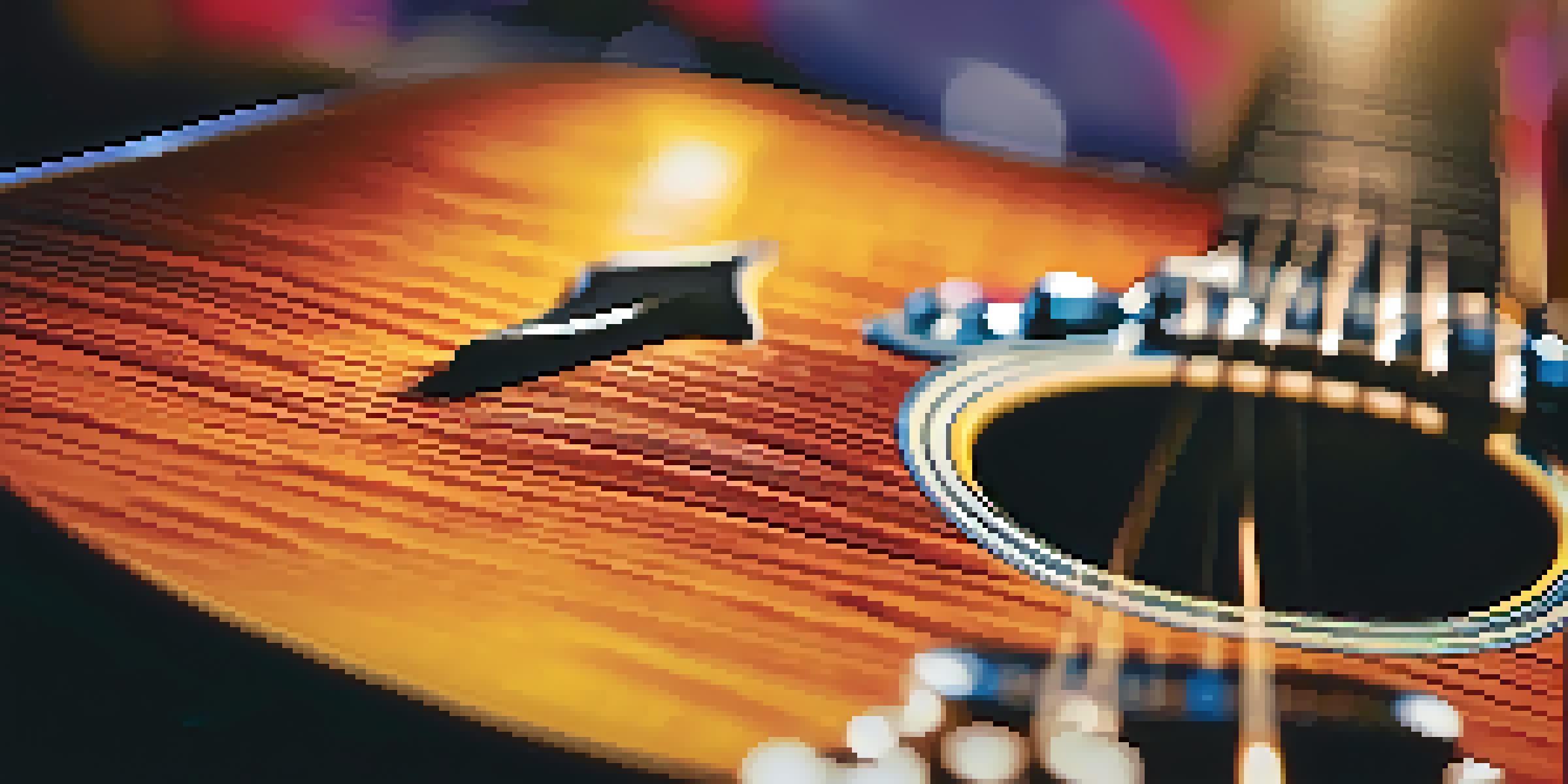Guitar Improvisation Techniques in Rock Music Explained

Understanding the Basics of Guitar Improvisation
Guitar improvisation is about creating spontaneous music, usually over a chord progression. It allows musicians to express their emotions and ideas in real-time. In rock music, improvisation can add excitement and freshness to a performance, making each show unique.
Improvisation is the ability to create something out of nothing.
To get started, it's essential to understand scales and how they relate to the chords you’re playing over. The pentatonic scale is particularly popular in rock because of its simplicity and versatility. Mastering this scale opens the door to a variety of expressions and styles.
Practice is key to improvisation; the more you play, the more comfortable you’ll become. Listening to your favorite rock guitarists can also inspire your own improvisational style, giving you a framework to build upon.
The Role of Scales in Rock Improvisation
Scales are the foundation of guitar improvisation, giving you a palette of notes to work with. In rock, the minor pentatonic and blues scales are particularly effective for creating that signature sound. These scales can evoke a range of emotions, from joy to melancholy, depending on how you use them.

Understanding the relationship between scales and chords is crucial. For example, if a song is in A minor, playing A minor pentatonic will generally fit well. This compatibility allows for fluid improvisation that feels natural and engaging.
Master Scales for Improvisation
Understanding and mastering scales, particularly the pentatonic and blues scales, is crucial for effective guitar improvisation.
Experimenting with different scales can also broaden your improvisational skills. You might find that mixing in the major scale or even modes can provide surprising and dynamic results, enhancing your overall sound.
Techniques for Enhancing Your Guitar Solos
Techniques like bending, sliding, and hammer-ons can add flair to your solos. Bending notes can create a vocal-like quality, while slides can make transitions between notes smoother. These techniques can electrify your improvisations, making them more expressive.
Music is the shorthand of emotion.
Additionally, incorporating techniques like vibrato can add depth and emotion to your playing. A well-timed vibrato can make a note linger, drawing the listener in and creating dramatic tension. This is especially effective in rock, where emotional intensity is often at the forefront.
Don't hesitate to mix techniques together. For example, you could bend a note, then slide into the next one, creating a seamless and captivating effect. The key is to practice these techniques until they feel second nature.
Listening Skills: The Key to Great Improvisation
One of the most underrated skills in improvisation is listening. Engaging with the music around you can provide insights into how to navigate your improvisation. Listening to other musicians—whether in a band or recordings—can inform your style and choices.
Pay attention to the dynamics of a song; knowing when to play softly or go all out can significantly impact your improvisation. For instance, if the band drops to a quieter section, you might choose to play more subtly, allowing space for the music to breathe.
Listening Enhances Your Skills
Developing strong listening skills allows guitarists to respond to the music around them, leading to more cohesive and engaging improvisations.
Moreover, practicing with backing tracks can help you develop your listening skills. This allows you to focus on responding to the music rather than just playing notes, ultimately leading to a more cohesive improvisational style.
The Importance of Rhythm in Improvisation
Rhythm is just as crucial as melody when it comes to improvisation. A strong sense of rhythm can make your solos feel alive and engaging, drawing listeners in. Experimenting with different rhythmic patterns can add variety and intrigue to your playing.
One way to enhance your rhythmic skills is to practice with a metronome. Gradually increasing the tempo can help you develop a better sense of timing and precision. This practice also allows you to explore syncopation, where you play off the beat for a more dynamic feel.
Remember that improvisation is not solely about playing fast; sometimes, playing slower with intention can create a more profound impact. Balancing speed with rhythmic complexity can elevate your improvisation to new heights.
Exploring Different Styles of Rock Improvisation
Rock music is incredibly diverse, with various sub-genres offering unique improvisational opportunities. From classic rock to punk and metal, each style has its own characteristics that can influence your approach to improvisation. Exploring these styles can help you find your voice as a guitarist.
For example, classic rock often emphasizes melody and emotion, while metal might focus on speed and technicality. By understanding these differences, you can adapt your improvisation to suit the style you're playing, making your performance more authentic.
Practice Regularly for Growth
Consistent practice and experimentation with different techniques and styles are essential for improving your improvisational skills.
Don’t shy away from blending genres, either. Mixing elements from blues, jazz, or even funk can lead to innovative improvisational techniques that set you apart as a guitarist, allowing you to create a signature sound.
Practice Tips for Improving Your Improvisation Skills
Regular practice is essential for honing your improvisation skills. Set aside time each week to focus solely on improvisation, experimenting with different techniques and styles. This consistent practice will help you build confidence and fluency in your playing.
Recording your improvisations can also provide valuable feedback. Listening back allows you to identify areas for improvement and track your progress over time. This self-reflection can be a game-changer, revealing patterns or habits you might want to change.

Lastly, don’t forget to have fun! Experiment with new ideas, and don’t be afraid to make mistakes. Each improvisational experience contributes to your growth as a musician, and the more you enjoy the process, the more natural your playing will become.